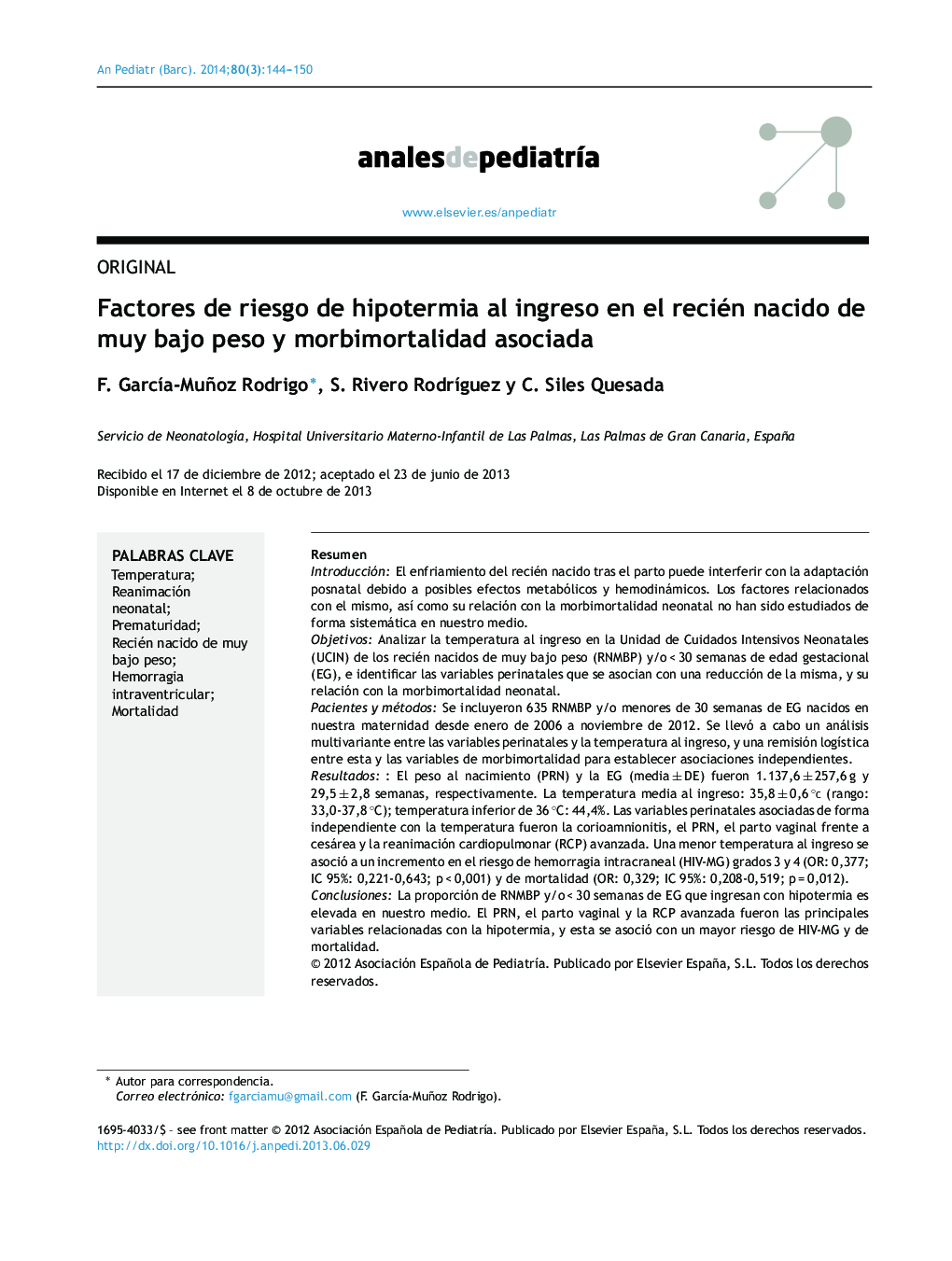| Article ID | Journal | Published Year | Pages | File Type |
|---|---|---|---|---|
| 4141526 | Anales de Pediatría | 2014 | 7 Pages |
ResumenIntroducciónEl enfriamiento del recién nacido tras el parto puede interferir con la adaptación posnatal debido a posibles efectos metabólicos y hemodinámicos. Los factores relacionados con el mismo, así como su relación con la morbimortalidad neonatal no han sido estudiados de forma sistemática en nuestro medio.ObjetivosAnalizar la temperatura al ingreso en la Unidad de Cuidados Intensivos Neonatales (UCIN) de los recién nacidos de muy bajo peso (RNMBP) y/o < 30 semanas de edad gestacional (EG), e identificar las variables perinatales que se asocian con una reducción de la misma, y su relación con la morbimortalidad neonatal.Pacientes y métodosSe incluyeron 635 RNMBP y/o menores de 30 semanas de EG nacidos en nuestra maternidad desde enero de 2006 a noviembre de 2012. Se llevó a cabo un análisis multivariante entre las variables perinatales y la temperatura al ingreso, y una remisión logística entre esta y las variables de morbimortalidad para establecer asociaciones independientes.Resultados: El peso al nacimiento (PRN) y la EG (media ± DE) fueron 1.137,6 ± 257,6 g y 29,5 ± 2,8 semanas, respectivamente. La temperatura media al ingreso: 35,8 ± 0,6 °C (rango: 33,0-37,8 °C); temperatura inferior de 36 °C: 44,4%. Las variables perinatales asociadas de forma independiente con la temperatura fueron la corioamnionitis, el PRN, el parto vaginal frente a cesárea y la reanimación cardiopulmonar (RCP) avanzada. Una menor temperatura al ingreso se asoció a un incremento en el riesgo de hemorragia intracraneal (HIV-MG) grados 3 y 4 (OR: 0,377; IC 95%: 0,221-0,643; p < 0,001) y de mortalidad (OR: 0,329; IC 95%: 0,208-0,519; p = 0,012).ConclusionesLa proporción de RNMBP y/o < 30 semanas de EG que ingresan con hipotermia es elevada en nuestro medio. El PRN, el parto vaginal y la RCP avanzada fueron las principales variables relacionadas con la hipotermia, y esta se asoció con un mayor riesgo de HIV-MG y de mortalidad.
IntroductionHeat loss in the newborn after delivery could interfere with post-natal adaptation due to metabolic and hemodynamic instability. Associated perinatal factors and their relationship with morbidity and mortality during the neonatal period have not been systematically studied in our unit.ObjectivesTo determine the temperature of very low birth weight (VLBW) infants on admission to our NICU, and to determine the associated perinatal variables, and the association of temperature with morbidity and mortality.Patients and methodsInfants born in our maternity from January 2006 to November 2012, with birth weights (BW) 401 g to 1,499 g and/or less than 30 weeks gestational age, were included. A multivariate analysis was performed using the perinatal variables and the temperature on admission, as well as a logistic regression between these and the morbidity-mortality variables, in order to detect any independent associations.ResultsA total of 635 infants were included, with a mean (±SD) birth weight and gestational age of 1,137.6 ± 257.6 g, and 29.5 ± 2.0 weeks, respectively. The mean admission temperature was 35.8 ± 0.6 °C (range: 33.0-37.8 °C). The proportion of infants with a temperature <36 °C was 44.4%. Independently associated perinatal variables were chorioamnionitis, birth weight, vaginal delivery, and advanced cardiopulmonary resuscitation (CPR). Admission hypothermia was associated with severe intraventricular haemorrhage (IVH) (grades 3 and 4) (OR: 0.377; 95% CI: 0.221-0.643; P<.001), and mortality (OR: 0.329; 95% CI: 0.208-0.519; P=.012).ConclusionsHypothermia on admission is frequent among our VLBW infants. Birth weight, vaginal delivery, and advanced CPR were the principal variables associated with hypothermia. A low temperature on admission was related to an increased risk of IVH and mortality.
